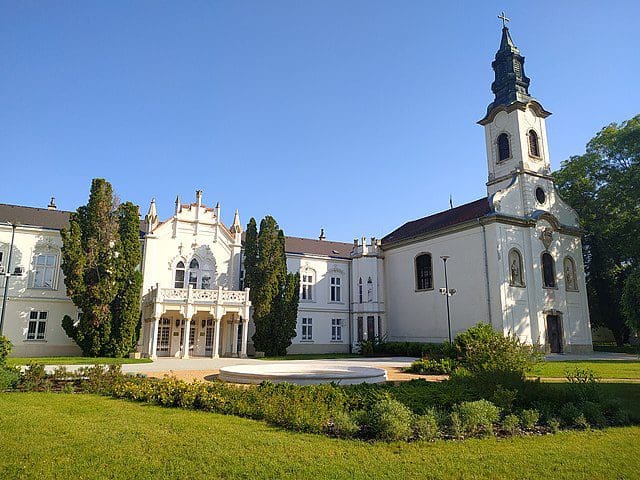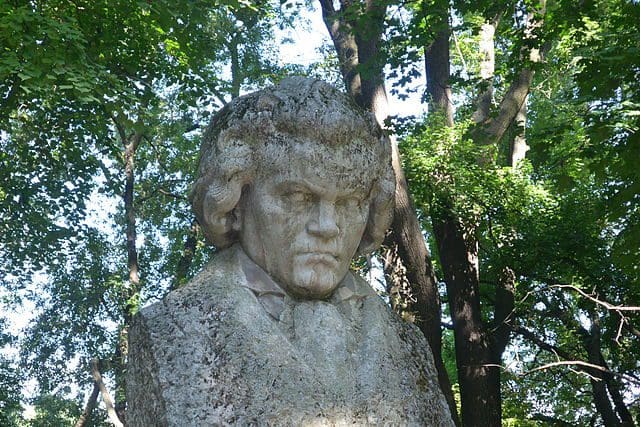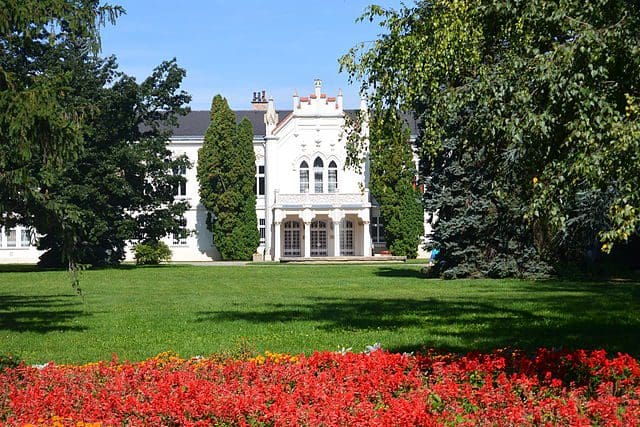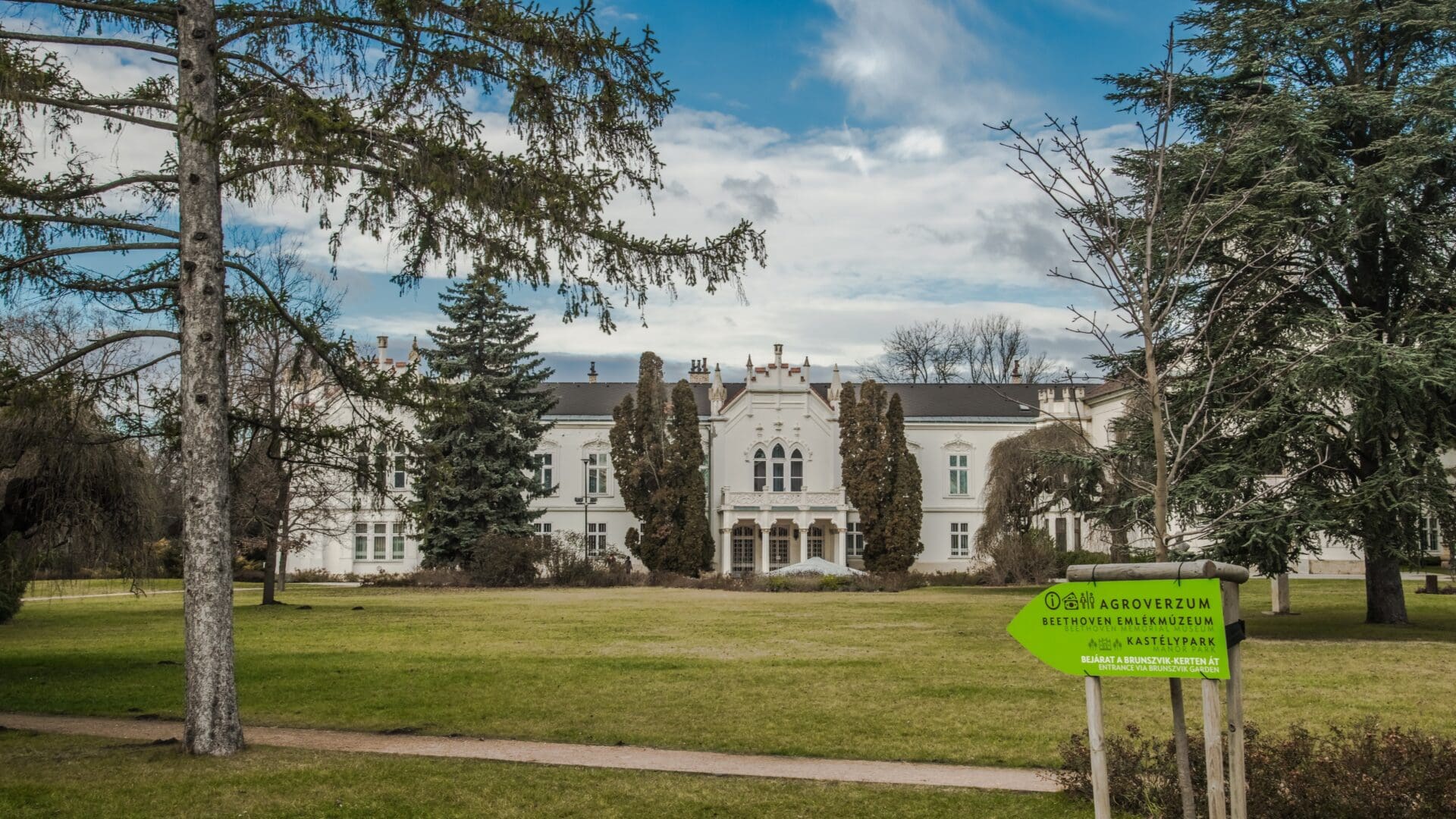One of the most beautiful castles in Hungary is the snow-white Brunsvik Castle designed in neo-Gothic style, located in Martonvásár, a small town within a half-hour drive of Budapest. The Hungarian aristocratic family, the Brunsviks transformed a swampy and barren wasteland into an idyllic English garden here, where their friend Ludwig van Beethoven, one of the most admired composers in the history of Western music, often visited them, deepening his tender feelings for one of the Brunsvik girls. Three exciting museums, an excellent restaurant, and a refreshing walk in the castle’s park await those who decide to pay a visit to the Brunsvik Castle in Martonvásár.
Although Martonvásár is already in Fejér County, it is still well within the boundaries of the Budapest agglomeration. The small town can be reached by train in thirty minutes, riding on urban train Z30, which departs from Budapest Déli pályaudvar (Déli Railway Station) every hour. The 20-kilometre distance from the city centre can also be covered by car in the same amount of time on the M7 motorway, but Martonvásár can also be reached easily when returning from or heading toward Lake Balaton.
It takes about half a day to wander around the little town of about 5,000 residents at an easy pace. The gem of the settlement is definitely the Brunsvik Castle, along with all its attractions.
The white-walled castle with gothic windows is usually called ‘the stronghold of the Hungarian Beethoven cult’, as the world-famous German composer visited it several times during his lifetime and maintained a good relationship with the Brunsvik family living on the estate for four generations. Those who are interested can learn about the details of this bond, which was not short of romantic passions either, in the Beethoven Memorial Museum operating in the castle today, but the composer’s cult has also been cherished for 60 years by the open-air Beethoven performances organised every summer on the island of the castle’s garden.
The garden of the castle is one of the most beautiful English gardens in our country, just as the neo-Gothic style of the castle that gives the place a very British appearance.
‘Everything around me reminded me of England, so much so that I almost imagined myself in England,’
wrote English doctor Richard Bright about the Brunsvik Castle in 1815. From certain points of view, some of its parts even remind us of Downton Abbey’s atmosphere, though, of course, the Brunsvik Castle is much smaller than that.

The Brunsvik family owned the estate from the beginning of the reign of Holy Roman Empress Maria Theresa. Its first owner, Antal Brunsvik, invited settlers to the village that was depopulated after the Ottoman rule and built a church that still stands next to the castle, St Anna Church. Later, his son, Antal Brunsvik Jr, built a one-story baroque building as a home with his wife, Anna Seeberg, who was an acquaintance of Beethoven’s. The couple had four children—the heyday of the estate is linked to their son Count Franz Brunsvik: he redesigned the exterior of the castle between 1784 and 1785, based on the plans of court architect József Tallherr, creating a new women’s section in the wing facing the church. Beethoven probably saw the castle in that form during his visits between 1800 and 1808.
Franz’s sister, Therese Brunsvik, became a world-famous kindergarten founder, while his other sister, Josephine, is regarded as Beethoven’s secret lover, the ‘Immortal Beloved’ of his letters. The daughter of the third sister, Charlotte, Blanka Teleki, was a woman who, just like her aunt Therese, acquired lasting merits in pedagogy and became one of the pioneers of Hungarian women’s education: in 1846, she established the first serious girls’ school in Hungary, for which she was even imprisoned after the Hungarian Revolution of 1848.
The Brunsvik Family’s Relationship with Beethoven
The mother of the four children, Anna Seeberg, was a big fan of Beethoven, and she even travelled to Vienna to persuade the composer, who was otherwise reluctant to teach, to give two of her daughters, Therese and Josephine, piano lessons for two weeks. Through the two sisters, the composer met their older brother, Franz, too, who then became one of his main supporters and a good friend until his death, arranging performances in Buda and other theatre works for him. Franz played the cello excellently, while his mother Anna accompanied him on the piano—they often played music together in the castle. Beethoven finished his Piano Sonata No 23, Appassionata, in Martonvásár, which he dedicated to his friend Franz Brunsvik.
Beethoven maintained a devoted intellectual relationship and correspondence with Therese (he even dedicated his Piano Sonata No. 24 F-sharp major, Op. 78 to her), while he approached Josephine with completely different feelings. Due to the difference in rank, marriage was out of the question, but their platonic relationship survived despite Josephine’s marriage to Count Joseph Deym in 1800, her widowhood, and even her subsequent remarriage—the two regularly had rendezvouses in Vienna. According to researchers,
Beethoven’s undated, mysterious letters addressed to his ‘Immortal Beloved’ were written to Josephine,
however, the pencil-written messages were only found in 1827, after the composer’s death.

In 2020, on Beethoven’s 250th birthday, the Brunsvik Castle’s exhibition was also renewed, which now presents the relationship between the Brunsvik family and the composer. It is, therefore, a new and contemporary exhibition with plenty of interactive elements: visitors can listen to different kinds of music; take selfies with contemporary figures; and learn about Beethoven’s other romantic affairs, too. Among the exhibited artefacts are the correspondence of the Brunsvik family, the diary of Therese Brunsvik, a lock of Beethoven’s hair in a medallion, and the family’s restored piano from 1829, made by Austrian piano maker Johann Baptist Streicher. Even famous Hungarian composer Franz Liszt played it in 1846.
There are also some offices in the other parts of the building, which are not open to the public. The castle’s owner is the Centre for Agricultural Research of the Hungarian Academy of Sciences (Agroverzum); their canteen can be found in the castle’s former barn. In the other building, there is a very exciting, interactive exhibition on the seemingly dry topic of agriculture, which is also worth checking out. (Tickets do not include admission to the Kindergarten Museum founded in memory of Therese Brunsvik, but it is located directly opposite the castle and visiting it can easily be fitted into a one-day programme.)
Count Franz Brunsvik modernised the castle only after 1822, rebuilding it in a classicist style and adding a second floor. However, it got its English neo-Gothic appearance already around 1875 when Franz’s son Géza rebuilt the edifice. At the end of the 19th century, the Brunsvik family, which fell into a difficult financial situation, was unfortunately forced to part with the estate after four generations: first, it was captured by Archduke Joseph August of Austria, then by brewer Antal Dreher, and after nationalisation, it became the property of the Centre for Agricultural Research of the Hungarian Academy of Sciences.
The Wasteland That Became a Fascinating English Garden
The English garden (or landscape garden) is characterised by the fact that, in contrast to the baroque French gardens, it does not strive for an over-regulated, artificial appearance, but rather for the garden to fit into the landscape and to act as a part of nature with its winding paths, spacious lawns, and picturesque groups of trees.
‘When my grandfather took over Martonvásár, he found only wasteland covered with water there. There was only one house, a few shepherd’s huts and a tree on eight thousand acres of dry land,’
wrote Therese Brunsvik in her diary.
The estate’s first owner, Antal Brunsvik, transformed the 7,500-acre swampy, treeless area: he planted fruit trees, willows and lindens, and marked the location of the future lake. His son, Antal Jr continued his work by planting chestnut trees and oak trees, and after his death, his wife Anna Seeberg also kept prettifying the adorable English garden. Their daughter Therese planted, as she called it, a ‘republic of linden trees’, a circle in which each tree represented a member of the family and friends—one of the trees even bore Beethoven’s name. A specimen of this circle is still alive and can be found behind the castle. Franz planted sycamores, various types of ash, Japanese pagoda, goldenrain trees, and alder in the park, and during the planning process, he also asked for the help of German gardener Christian Heinrich Nebbien, who, among others, also designed the City Park in the capital.

In addition to the native ones, several exotic species were also planted, such as silver pines, Oregon blue false cypresses, Chinese mammoth pines, tulip trees, and black walnuts. There are still a couple of several-hundred-year-old methuselahs from the early 1800s. Ethnobiological and cultural-historical knowledge is well served by the educational trail running through the park, which also leads to the island fed by the Saint Ladislaus Stream, where the open-air stage is located, and where visitors can also admire Beethoven’s favourite spot within the estate. Here stands one of the prides of the park, the American swamp cypress from the early 1800s, with its 5-metre trunk and its special aerial roots.
If you only want to take a walk, look around, and enjoy the view of the castle from afar, you can buy a ticket to the park for HUF 900 (you can find more information about the prices here). If you are lucky enough to catch a guided tour of the park’s history, you should not miss the opportunity! Before visiting the museums, it is also worth stopping for lunch at the Postakocsi Restaurant next to the castle, which is another famous venue of Martonvásár with its rich past—it was built in 1768 and has been operating as a restaurant ever since. The restaurant underwent a major renovation a few years ago and has been offering Hungarian–Italian dishes since then, with, among others, fantastic ravioli, pizza, and cheesecake on its menu. If you happen to visit Martonvásár and the Brunsvik Castle, your day will definitely not be short of outdoor and indoor cultural programmes and a delicious lunch in a friendly garden.
Related articles:
Click here to read the original article.








